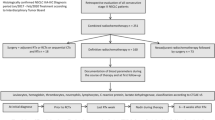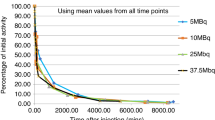Abstract
Summary: The present study was designed to evaluate the red blood cell (RBC) radiolabeling technique utilizing the short half-lived radio-nuclide technetium-99m and to compare the results with the well-recognized standard chromium-51 method. The procedure was evaluated in a canine and a newborn lamb model utilizing dual radionuclide labeling and counting techniques. With the express purpose of providing a significant radiation dose reduction, the procedure presented was adapted for utilization in a neonatal patient population. Statistical analysis of the data revealed that there was no significant difference in the radiolabeling efficiency for the two methods (Cr-51, 86.6%; Tc-99m, 92.4%). Assessment of the in vivo stability for technetium-99m RBCs showed that less than a 4% loss of radiolabel from the RBC was seen in a 4-hr time span in the canine model (15 min, 90.5%; 2 hr, 88.9%; 4 hr, 86.6%) when compared to the 15 min equilibrium sample.
Evaluation of newborn lamb RBC volumes showed that the technetium-99m RBC volume did not significantly differ from the chromium-51 labeling technique (Cr-51, 24.0 ml/kg; Tc-99m, 23.2 ml/kg). Summarization of the whole-body radiation dose showed that greater than a 30-fold reduction in absorbed dose was achieved in the newborn (Cr-51,30.0 mrad; Tc-99m, 0.9 mrad). The modified procedure presented for the radiolabeling of the RBC with the short half-lived radionuclide technetium-99m provides a technique comparable to the utilized standard chromium-51 RBC method, yet with a large reduction in absorbed radiation dose. This procedure is presented as a superior technique for the determination of pediatric RBC volumes.
Speculation: Demonstration of the efficacy of radionuclide dilution techniques in two species (animal models) predicates for the application of this procedure in neonates. The accurate assessment of circulating red blood cell volume affords the neonatologist a unique management tool while accruing significant radiation dose reduction using the short half-lived technetium-99m rather than the standard chromium-51 technique.
Similar content being viewed by others
Log in or create a free account to read this content
Gain free access to this article, as well as selected content from this journal and more on nature.com
or
Author information
Authors and Affiliations
Rights and permissions
About this article
Cite this article
Dirksen, J., Quaife, M., Paxson, C. et al. Evaluation and Testing of In Vitro Labeled Technetium Tc-99m Red Blood Cells in Two Animal Models for Neonatal RBC Volume Determinations. Pediatr Res 15, 905–907 (1981). https://doi.org/10.1203/00006450-198106000-00004
Issue date:
DOI: https://doi.org/10.1203/00006450-198106000-00004



